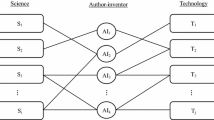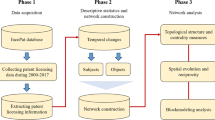Abstract
The patents of China in biotechnology in the United States Patent and Trademark Office during 1995–2008 have been analyzed in this paper with the help of bibliometrics and social network analysis techniques. The analysis has been carried out from several perspectives including total patent output of industries, universities and public research institutes (PRIs) and their positions in the knowledge network, the main innovators and their interactions, the collaboration among Chinese regions and the collaborations from abroad. The results show that though with some improvements, the patent performance of Chinese organizations and regions in biotechnology still need to be improved. The connections between Chinese innovators are not very cohesive and they depend heavily on foreign knowledge, especial knowledge from U.S. multinational firms and universities. The important innovators of China in this field are mainly PRIs and universities. More and stronger firm innovators, especially large and powerful multinational companies, are strongly needed for the nation’s biotechnology industry.



Similar content being viewed by others
Notes
Revealed technology advantage of country A in technology I is calculated by the share of I in A’s patents relative to the share of I in total patents. Patent counts are based on the priority data, the inventor’s country of residence and use fractional counts on PCT filings at international phase (EPO designations) (OECD 2008).
References
BIO. (2008). Guide to biotechnology 2008. Washington, DC: BIO.
Breschi, S., & Malerba, F. (Eds.). (2005). Clusters. Oxford: Networks and Innovation Oxford University Press.
Cantner, U., & Graf, H. (2006). The network of innovators in Jena: An application of social network analysis. Research Policy, 35(4), 463–480.
Chen, Z. F., & Guan, J. C. (2010). The impact of small world on innovation: An empirical study of 16 countries. Journal of Informetrics, 4(1), 97–106.
Ernst and Young LLP. (2007). Beyond borders: the global biotechnology report 2007. Palo Alto: Ernst and Young LLP.
Fleming, L., King, C., & Juda, A. I. (2007). Small worlds and regional innovation. Organization Science, 18, 938–954.
Gao, X., & Guan, J. C. (2009a). Networks of scientific journals: An exploration of Chinese patent data. Scientometrics, 80(1), 283–302.
Gao, X., & Guan, J. C. (2009b). A scale-independent analysis of the performance of the Chinese innovation system. Journal of Informetrics, 3(4), 321–331.
Gilding, M. (2008). ‘The tyranny of distance’: Biotechnology networks and clusters in the antipodes. Research Policy, 37, 1132–1144.
Glaser, V. (2007). China expanding bioresearch acivities. Genetic Engineering and Biotechnology News, 27(28), 1.
Guan, J. C., & He, Y. (2007). Patent-bibliometric analysis on the Chinese science-technology linkages. Scientometrics, 72(3), 403–425.
Guan, J. C., & Wang, G. B. (2010). A comparative study of research performance in nanotechnology for China’s inventor-authors and their non-inventing peers. Scientometrics, 84(2), 331–343.
Hanaki, N., Nakajima, R., & Ogura, Y. (2010). The dynamics of R&D network in the IT industry. Research Policy, 39(3), 386–399.
Hertzum, M. (2008). Collaborative information seeking: The combined activity of information seeking and collaborative grounding. Information Processing & Management, 44, 957–962.
Hinze, S., & Schmoch, U. (2005). Opening the black box. In H. F. Moed, W. Glänzel, & U. Schmoch. (Eds.), Handbook of quantitative science and technology research (pp. 215–235). Dordrecht: Kluwer Academic Publishers.
Hu, A. G. Z., & Jaffe, A. B. (2003). Patent citation and international knowledge flow: The case of Korea and Taiwan. International Journal of Industrial Organization, 21(6), 849–880.
Kim, M.-J. (2007). A bibliometric analysis of the effectiveness of Korea’s biotechnology stimulation plans, with a comparison with four other Asian nation. Scientometrics, 72(3), 371–388.
Lecocq, C., & Van Looy, B. (2009). The impact of collaboration on the technological performance of regions: Time invariant or driven by life cycle dynamics? An explorative investigation of European regions in the field of biotechnology. Scientometrics, 80(3), 845–865.
Lee, S., & Bozeman, B. (2005). The impact of research collaboration on scientific productivity. Social Studies of Science, 35(5), 673–702.
Lim, H., & Park, Y. (2010). Identification of technological knowledge intermediaries. Scientometrics, 84, 543–561.
Liu, X. L., & White, S. (2001). Comparing innovation systems: a framework and application to China’s transitional context. Research Policy, 30, 1091–1114.
Nasir, A., Ali, T. M., Shahdin, S., & Rahman, T. U. (2010). Technology achievement index 2009: Ranking and comparative study of nations. Scientometrics. doi:10.1007/s11192-010-0285-6.
OECD. (2005). A framework for biotechnology statistics. Paris: OECD.
OECD. (2008). Compendium of patent statistics. Paris: OECD.
Patra, S. K., & Chand, P. (2005). Biotechnology research profile of India. Scientometrics, 63(3), 583–597.
Podolny, J., & Page, K. (1998). Network forms of organization. Annual Review of Sociology, 24, 57–76.
Powell, W. W. (1990). Neither market nor hierarchy: Network forms of organization. Research in Organizational Behaviour, 12, 295–336.
Ramani, S. V., & Looze, M. A. (2002). Using patent statistics as knowledge base indicators in the biotechnology sectors: An application to France, Germany and the U.K. Scientometrics, 54(3), 319–346.
Yuan, J. P., Yue, W. P., Su, C., et al. (2010). Patent activity on water pollution and treatment in China: A scientometric perspective. Scientometrics, 83, 639–651.
Acknowledgments
This research is funded by the National Natural Science Foundation of China (Project no. 70773006) and the National Social Science Foundation of China (Project no. 10zd&014).The authors are very grateful for the valuable comments and suggestions of the anonymous reviewers and Editor-in-Chief Prof. Braun, which significantly improved the article.
Author information
Authors and Affiliations
Corresponding author
Additional information
These authors contributed equally to this paper.
Rights and permissions
About this article
Cite this article
Chen, Z., Guan, J. Mapping of biotechnology patents of China from 1995–2008. Scientometrics 88, 73–89 (2011). https://doi.org/10.1007/s11192-011-0380-3
Received:
Published:
Issue Date:
DOI: https://doi.org/10.1007/s11192-011-0380-3




